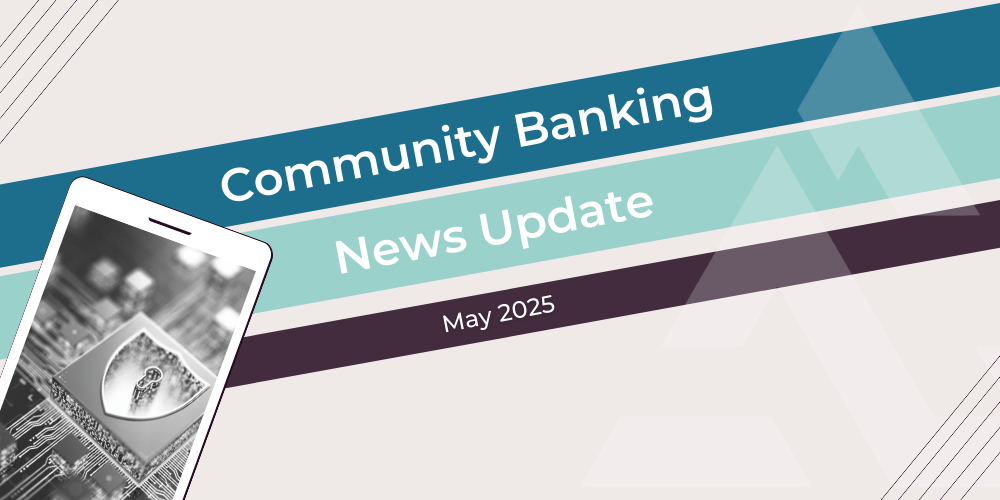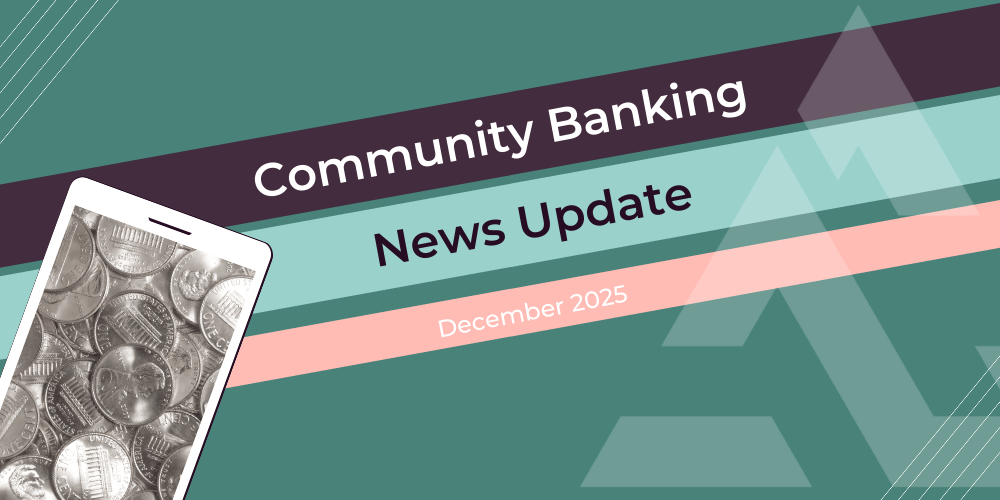The Year in Cross-Border Payments and Correspondent Banking
International wire automation, stablecoins, wallets, and AI reshape global money movement What a pivotal year in cross-border payments. No one...
6 min read
 Daisy Lin, Head of Marketing, Acceleron
:
4/29/25 8:18 AM
Daisy Lin, Head of Marketing, Acceleron
:
4/29/25 8:18 AM

Welcome to this month’s Community Banking News update, your go-to roundup of the biggest news developments affecting community banks and credit unions — plus why they matter. Last month, we covered the U.S. government elimination of paper checks, FDIC crypto rule easing, and more. (Missed it? Catch up here.)
This month, the Federal Reserve also gives banks a green light to engage in crypto activities. In addition, Financial institutions are upping their investment in generative AI, while Federal Reserve Governor Michael Barr calls for increased defenses against AI deepfakes. Meanwhile, major upheavals are shaking up the National Credit Union Administration, Fednow expands to 1,300 financial institutions, and the Capital One-Discover merger receives regulatory approval. How do these developments impact community banking institutions? Read on to find out.
The Federal Reserve has formally rescinded its previous guidance warning banks about the risks of engaging with crypto assets, aligning with recent moves by the FDIC and OCC. In a shift from earlier policy, the Fed will no longer require banks to proactively provide notification about crypto and stablecoin activities, choosing to monitor them as part of normal supervision. While regulators still emphasize that banks must manage risks prudently, the withdrawal signals a potential shift toward a more tolerant stance on crypto banking activities.
Meanwhile, two bills are now making their way through Congress that would regulate the issuance and use of stablecoins — the STABLE Act in the House and the GENIUS Act in the senate.
The rollback of anti-crypto guidance and pending stablecoin legislation could open the door for community banks to cautiously explore digital asset services if they choose to. While crypto remains volatile, offering custodial services, payments innovation, or partnerships with stablecoin providers could become more feasible without facing immediate regulatory pushback. However, risk management expectations will stay high, meaning any crypto-related activities must be approached carefully, with strong compliance frameworks in place.
We recently talked with Ethan Singleton, Managing Principal at FS Vector, about the future of stablecoins. Read his insights here: https://acceleronbank.com/articles/fiat-cryptocurrency
Financial institutions are intensifying their investments in foundational technologies, specifically cloud infrastructure, cybersecurity, and data platforms, to facilitate the integration of generative AI (GenAI) into their operations. According to Broadridge Financial Solutions' 2025 Digital Transformation & Next-Gen Technology Study, 72% of surveyed firms are making moderate to large investments in GenAI, nearly doubling from the previous year. Concurrently, respondents continue to prioritize spending on cybersecurity, analytics, and cloud platforms, recognizing these as essential underpinnings for successful AI deployment.
The study also highlights a significant increase in IT budgets allocated to technology innovation, rising to 29% over the next two years, a 7 percentage point uptick from the previous year. While many institutions anticipate productivity gains from GenAI, challenges persist, particularly regarding data quality and legacy system constraints. Nearly half of the surveyed organizations report issues with data silos, underscoring the need for comprehensive data modernization efforts to fully leverage AI capabilities.
Why This Matters to Community Banks and Credit Unions:
AI is here, there’s no denying it. For community banks and credit unions, the push towards GenAI presents both opportunities and challenges. While larger institutions may have the resources to invest heavily in AI and the necessary supporting technologies, smaller institutions often operate with more limited budgets. However, the emphasis on foundational technologies like cloud computing and cybersecurity is particularly pertinent. Investing in these areas not only prepares community FIs for future AI integration but also enhances overall operational efficiency and security.
Read our interview with the Tonya Perez Wright, the Chief Experience Officer of USC Credit Union, about AI adoption and digital transformation:
On the flipside of the AI boom, Federal Reserve Governor Michael Barr has called on banks to enhance their defenses against the growing threat of AI-generated deepfakes. Speaking at a New York Federal Reserve event, Barr emphasized that financial institutions must learn to adopt advanced AI technologies such as facial recognition, voice analysis, and behavioral biometrics to detect and prevent sophisticated fraud attempts. He highlighted that one in ten companies has experienced deepfake attacks, underscoring the urgency for banks to upgrade their cybersecurity measures.
Barr warned that as deepfake technology becomes more accessible to criminals, traditional security measures like voice authentication could be compromised. He described cybercrime as an "asymmetrical" challenge, where attackers can exploit vulnerabilities at low cost, while banks face higher expenses to implement effective defenses. To address this imbalance, Barr suggested that regulators should work to increase the cost of attacks for cybercriminals and reduce the defensive burdens on financial institutions.
Why This Matters to Community Banks and Credit Unions:
Keeping up with fin-criminals is a priority for community banks and credit unions. Barr's remarks highlight the necessity for these community FIs to invest in AI-driven security solutions to protect their customers and maintain trust. Moreover, collaboration with regulators and industry peers can provide community banks with access to shared resources and best practices for combating deepfake threats. By proactively adopting advanced security measures and participating in collective defense strategies, community banks and credit unions can enhance their resilience against emerging cyber threats and safeguard their operations and customers.
Read our primer on secure data storage for bankers:
The National Credit Union Administration (NCUA) is navigating a period of significant upheaval following the dismissal of its two Democratic board members, Todd Harper and Tanya Otsuka, by President Donald Trump. This action leaves Republican Chairman Kyle Hauptman as the sole board member, raising questions about the agency's ability to function effectively. While the NCUA asserts that it can continue operations under existing delegations of authority, legal experts argue that substantive regulatory actions may require a quorum of at least two members, as stipulated in 12 CFR § 791.2.
Compounding the governance challenges, the NCUA has experienced a significant workforce reduction, with approximately 220 employees accepting voluntary resignation offers. This move aligns with the Trump administration's broader efforts to downsize the federal workforce.
The current state of the NCUA's board could lead to regulatory uncertainty for credit unions, particularly regarding the implementation of new rules or amendments to existing regulations. Furthermore, the significant reduction in NCUA staff may affect the agency's ability to conduct timely examinations and provide support to credit unions. Engaging with industry associations may be prudent to navigate potential changes in regulatory oversight and to prepare for any shifts in enforcement or policy direction.
The Federal Reserve's FedNow Service has achieved a significant milestone, now boasting participation from over 1,300 financial institutions across all 50 states. Notably, 95% of these participants are small to mid-sized banks, credit unions, and financial firms, highlighting the service's appeal to community-focused institutions. In the first quarter of 2025, FedNow processed approximately 1.3 million transactions, marking a 43% increase compared to the same period last year, with daily transaction volumes averaging $540 million.
FedNow's versatility is evident in its diverse use cases, including digital wallet funding, off-cycle payroll, online marketplace payouts, earned wage access, auto loan disbursements, and real estate escrow payments. To accommodate growing demand, the Federal Reserve plans to double the transaction limit from $500,000 to $1 million this summer. Additionally, new features will allow financial institutions to set specific transaction amounts and speeds for defined customer segments.
The rapid adoption of FedNow by community banks and credit unions underscores the importance of real-time payment capabilities in today's financial landscape. By leveraging FedNow, community FIs can offer faster, more efficient payment solutions, enhancing customer satisfaction and competitiveness. The service's scalability and upcoming enhancements provide opportunities for tailored financial products, aligning with the unique needs of local communities. This proactive approach not only meets current customer expectations but also sets the stage for future innovations in financial services delivery.
Read our interview with the instant payments maven Marcia Klingensmith for implementation tips:
Capital One's $35 billion all-stock acquisition of Discover Financial Services has secured final regulatory approvals from the Federal Reserve and the Office of the Comptroller of the Currency (OCC), positioning the combined entity as the largest U.S. credit card issuer by loan volume. The merger, expected to close on May 18, 2025, will also make Capital One the nation's eighth-largest bank by assets, totaling approximately $660 billion.
The OCC's approval is contingent upon Capital One submitting a plan within 120 days post-closing to address the causes of enforcement actions against Discover, including a $100 million fine and $1.225 billion in customer restitution related to interchange fee overcharges. Capital One CEO Richard Fairbank described the merger as a "singular opportunity" to create a leading consumer banking and payments platform, leveraging Discover's payment network to reduce reliance on intermediaries like Visa and Mastercard.
While headlines focus on credit cards and scale, there’s a deeper shift worth watching. Capital One’s acquisition of Discover could challenge the Visa-Mastercard duopoly by strengthening the Discover payment network, and that may eventually create more options for community banks and credit unions. The merger also underscores the ongoing consolidation in financial services and the need for community banks to evaluate how they’ll stay competitive in a reshaped payments landscape. Community banks and credit unions may want to reassess their strategic partnerships and technology investments to remain competitive.
Read about Acceleron’s partnership with Metropolitan Capital Bank and Trust:
Acceleron builds patented software that allows community banks and credit unions to conduct international payment transactions profitably through a correspondent banking marketplace. Serving over 200 financial institutions and facilitating more than $1 billion in international payments annually, Acceleron helps community financial institutions generate non-interest income and compete more effectively with high-fee big banks. Our solutions integrate seamlessly with top payments platforms, ensuring quick implementation and smooth operation.
Subscribe to our monthly newsletter, "The Exchange," to stay ahead of the curve and get original content you won't find anywhere else!

International wire automation, stablecoins, wallets, and AI reshape global money movement What a pivotal year in cross-border payments. No one...

New rules, no pennies, and next-generation rails: this month’s biggest banking news As the year winds down, the industry isn’t slowing. The Fed is...

The SVP, Head of Business Development for Service Providers at The Clearing House talks instant payments, bourbon, and fraud. When you talk to...